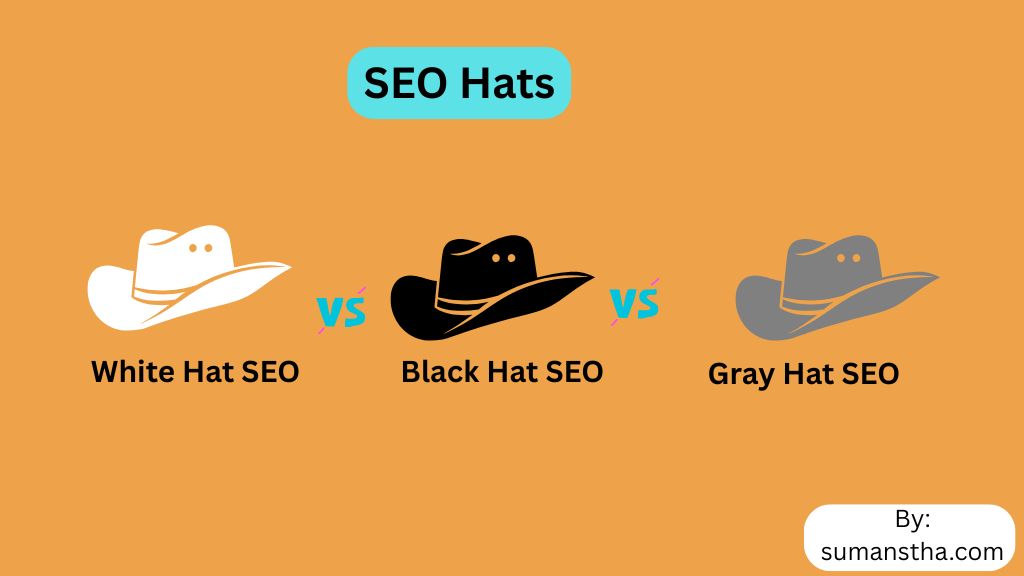When it comes to SEO, not all strategies adhere to the same rules, and choosing the wrong one can either boost your rankings or result in your site being penalized. So, what’s the real difference between White Hat vs Black Hat SEO, and Gray Hat SEO?
White Hat SEO plays fair and builds long-term trust with Google by following white hat SEO best practices.
Black Hat SEO cuts corners and chases fast (but risky) wins using black hat SEO tactics.
Gray Hat SEO walks the line — not right, not wrong — often using grey hat SEO techniques that can be risky.
In this guide, you’ll learn how each approach works, what’s safe, risky, and which path is right for your website by understanding seo hat strategies comparison.
What is White Hat SEO?

White Hat SEO means doing SEO the honest and correct way. This approach follows all of Google’s guidelines and focuses on improving the experience for real users. It aligns with ethical SEO principles and takes time and effort, but leads to long-lasting, safe results.
Key qualities of White Hat SEO
- Follows Google’s rules and white hat SEO best practices
- Focuses on quality, value, and user satisfaction
- Safe from being punished or de-ranked by Google
- Builds trust and reputation over time
Best Practices
- Creating High-Quality Content – It includes writing posts, guides, and product pages that answer real questions people have.
- Using Keywords the Right Way – Researching and using keywords naturally, avoiding keyword stuffing.
- Improving Website Structure – Using clear titles, descriptive meta tags, alt text, and internal linking.
- Optimizing for Mobile Devices – Ensuring mobile-friendliness as Google favors this.
- Making the Site Fast – Compress images, reduce scripts, and use good hosting.
- Building Natural Backlinks – Earning links naturally rather than buying or trading them.
Note: Writing a helpful guide titled “How to Start a Vegetable Garden at Home” using ethical SEO techniques and structuring it well is an example of white hat SEO.
Pros:
- Safe and ethical
- Builds long-term authority
- Improves user satisfaction
- Protected from Google penalties
Cons:
- Takes longer to see results
- Requires more time and effort
What is Black Hat SEO?

Black Hat SEO is the shady side of SEO. It uses shortcuts and tricks to fool search engines and boost rankings quickly. While these tactics might work at first, they often backfire. Search engines are smart, and when they catch you breaking the rules, they can penalize or ban your site.
Risky Activities
- Violates Google’s rules
- Focuses on manipulating rankings instead of helping users
- Often leads to penalties or bans
- High-risk, short-term strategy
Tactics That Break the Rules
- Keyword Stuffing – Repeating the same keyword many times in one article just to try to rank. For example: “Looking for cheap shoes? We have cheap shoes. Buy cheap shoes now!”
- Cloaking – Showing different content to users and to search engines. This can mislead Google and result in a manual penalty.
- Buying Links – Paying other sites to link to yours, instead of earning those links through quality content.
- Using Hidden Text – Hiding keywords by making them the same color as the background or using tiny fonts, so search engines see them but users don’t.
- Scraping Content – Copying content from other websites without permission and reposting it on your site.
- Spammy Backlink Practices – Posting your website link on unrelated blog comments, forums, or social media pages to create backlinks artificially.
Example: Copying a popular blog post and flooding it with keywords is a classic black-hat SEO example from 2025.
Pros:
- May bring quick traffic
- Requires less initial effort
Cons:
- High risk of penalties
- Can damage your site’s reputation
- Results don’t last
What is Gray Hat SEO?

Gray Hat SEO is a mix of both worlds. It includes tactics that are not clearly against the rules, but not fully approved either. These methods may work for a time, but they could also get your site penalized if search engines update their policies.
Features of Gray Hat SEO:
- Sits between right and wrong
- May follow the letter but not the spirit of the rules
- Could become Black Hat with future Google updates
- Often used by aggressive marketers
Detailed Examples of Gray Hat SEO:
- Clickbait Headlines – Writing exaggerated or misleading headlines to get clicks. The article might be okay, but the headline overpromises.
- Spinning Articles – Using tools to rewrite articles from other sites just enough to avoid duplicate content penalties, without really adding new value.
- Using Expired Domains – Buying old domains that already have backlinks and using them for a different purpose, just to benefit from their SEO strength.
- Overusing Guest Posts – Writing many guest posts just for the backlinks instead of contributing value to the audience.
- Faking Social Proof – Creating fake reviews, comments, or testimonials to make your site look more trusted.
Example: Using a program to rewrite a competitor’s article fits how grey hat SEO works.
Pros:
- Can deliver faster results than White Hat
- Might avoid penalties if done carefully
Cons:
- Still carries risk
- May become Black Hat overnight
- May not build real trust or authority
Which SEO Approach is Best?
The best choice depends on your goals, but here’s what most experts agree on:
- Choose White Hat SEO if you want long-term growth, safety, and credibility.
- Avoid Black Hat SEO unless you’re okay with taking big risks and possibly losing everything.
- Be cautious with Gray Hat SEO — it might work today, but could hurt you tomorrow.
If your goal is to build something real and lasting, stick with white hat SEO best practices. They help build trust with both your audience and Google.
Quick Comparison: White Hat vs. Black Hat vs. Gray Hat
| Feature | White Hat SEO | Black Hat SEO | Gray Hat SEO |
|---|---|---|---|
| Follows the Rules | Yes | No | Sometimes |
| User-focused? | Yes | No | Not always |
| Risk Level | Low | High | Medium |
| Time to Results | Slower but lasting | Fast but risky | Moderate |
| Example | Writing original, helpful content | Keyword stuffing, content theft | Spinning content, fake reviews |
Conclusion
Understanding white hat vs black hat SEO and grey hat SEO is essential for anyone who wants to grow a website the right way. If you want traffic that lasts and builds your reputation, choose white hat SEO. It may take longer, but it’s worth it. You’ll stay safe from penalties, and people will trust your site more.
Stay away from black hat SEO unless you’re prepared to lose your rankings, traffic, or domain. If you’re tempted by gray hat SEO, remember that the risks of gray hat SEO tactics are real, and what’s allowed today might not be tomorrow.
The best question to ask yourself is: “Would I do this if search engines didn’t exist?” If the answer is no, it’s probably not a good idea.
Focus on value, play fair, and you’ll win in the long run — not just with search engines, but with your audience too.
FAQs: Common Questions About SEO Practices
- Is Black Hat SEO illegal?
Black Hat SEO isn’t illegal, but it violates search engine rules. If caught, your site can be penalized or removed, seriously harming your traffic and business. - Can Gray Hat SEO become Black Hat over time?
Yes. Gray hat vs black hat SEO differences blur when search engines change guidelines. What seems acceptable today might be punished tomorrow. That’s why grey hat SEO safety is always a concern. - How long does it take to see results with White Hat SEO?
White Hat SEO is a long-term strategy. Early results may show in 3–6 months, with significant growth after consistent effort over 6–12 months or more. - Can I mix White Hat and Gray Hat SEO?
Many do, but it’s risky. Mixing clean and borderline strategies can confuse your approach and make you vulnerable to penalties if Google updates its algorithms. - What’s the safest way to build backlinks?
Create great content that others want to link to naturally. Guest posting on reputable sites, sharing useful resources, and building relationships are safe white hat SEO best practices.



